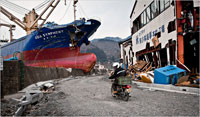 Recent articles on the power of the tsunami that recently struck Japan say a lot about both the power of the tsunami waves and the challenges of trying to cope with a constant threat from the ocean. Japan’s first line of defense against tsunamis has been its extensive investment in seawalls. As reported by the New York Times: At least 40 percent of Japan’s 22,000-mile coastline is lined with concrete seawalls, breakwaters or other structures meant to protect the country against high waves, typhoons or even tsunamis. They are as much a part of Japan’s coastal scenery as beaches or fishing boats, especially in areas where the government estimates the possibility of a major earthquake occurring in the next three decades at more than 90 percent, like the northern stretch that was devastated by Friday’s earthquake and tsunami.
Recent articles on the power of the tsunami that recently struck Japan say a lot about both the power of the tsunami waves and the challenges of trying to cope with a constant threat from the ocean. Japan’s first line of defense against tsunamis has been its extensive investment in seawalls. As reported by the New York Times: At least 40 percent of Japan’s 22,000-mile coastline is lined with concrete seawalls, breakwaters or other structures meant to protect the country against high waves, typhoons or even tsunamis. They are as much a part of Japan’s coastal scenery as beaches or fishing boats, especially in areas where the government estimates the possibility of a major earthquake occurring in the next three decades at more than 90 percent, like the northern stretch that was devastated by Friday’s earthquake and tsunami.
The headline of the article says all that need be said: Seawalls Offered Little Protection Against Tsunami’s Crushing Waves . A follow-up article touches on the downside of relying on a fixed defense against the power of the sea.
In Japan, Seawall Offered a False Sense of Security
So unshakable was this town’s faith in its sea wall and its ability to save residents from any tsunami that some rushed toward it after a 9.0-magnitude earthquake struck off the coast of northeast Japan on the afternoon of March 11.
After all, the sea wall was one of Japan’s tallest and longest, called the nation’s “Great Wall of China” by the government and news media. Its inner wall was reinforced by an outer one, and they stretched 1.5 miles across the bay here. The surface was so wide that high school students jogged on it, townspeople strolled on it, and some rode their bicycles on it. A local junior high school song even urged students: “Look up at our sea wall. The challenges of tsunamis are endless.”
But within a few minutes on March 11, the tsunami’s waves tore through the outer wall before easily surging over the 34-foot-high inner one, sweeping away those who had climbed on its top, and quickly taking away most of the town of Taro.
“For us, the sea wall was a source of pride, an asset, something that we believed in,” said Eiko Araya, 58, the principal of Taro No. 3 Elementary School. Like several other survivors, Ms. Araya was walking atop the inner wall late Wednesday afternoon, peering down at the ruins of Taro. “We felt protected, I believe. That’s why our feeling of loss is even greater now.”
Original reports put the size of the tsunami at roughly 10 meters. Analysis now suggests that the wave may have been roughly 38 meters, or almost four times higher in at least one location, equaling or exceeding the record 1896 Meiji Sanriku Earthquake Tsunami.
